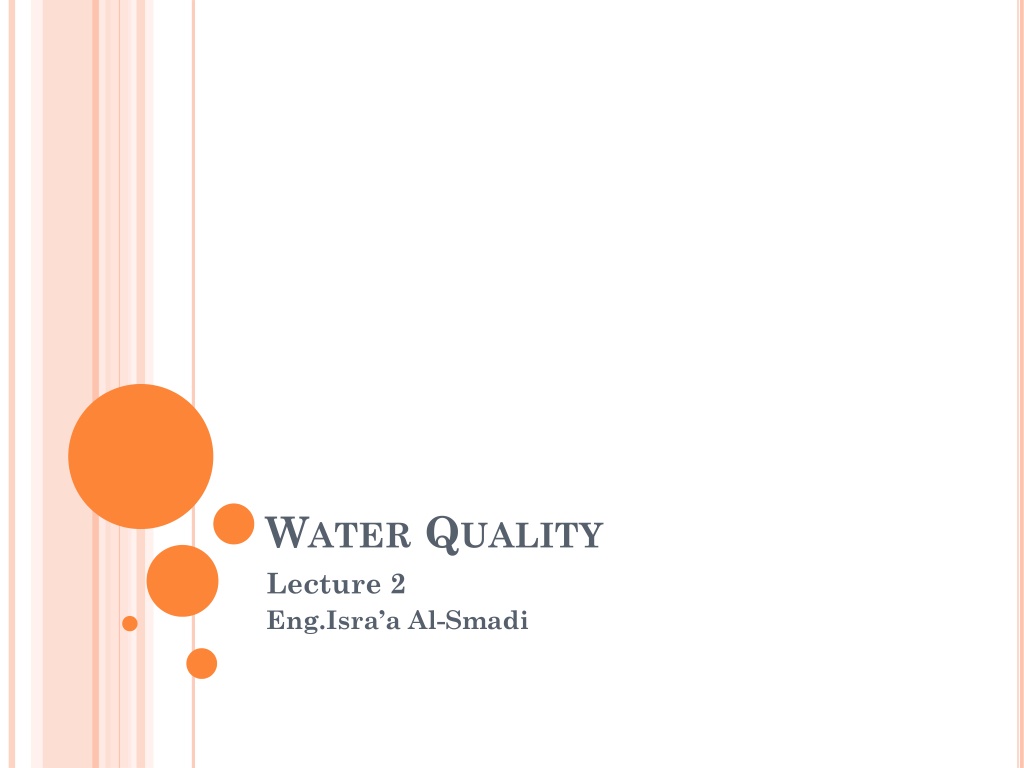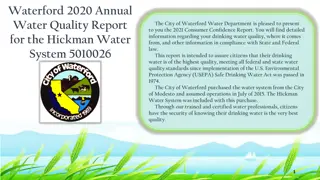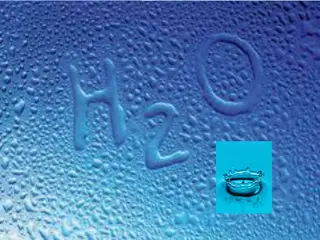Understanding Water Quality Parameters and Characteristics
Water quality encompasses physical, chemical, and biological characteristics that determine its suitability for various uses. Physical parameters like turbidity, taste, odor, color, and temperature affect sensory perception. Chemical parameters such as pH, acidity, alkalinity, and hardness relate to water's solvent properties, while bacteriological characteristics indicate pollution levels. Ensuring water quality is crucial for safeguarding human health and environmental integrity.
Download Presentation

Please find below an Image/Link to download the presentation.
The content on the website is provided AS IS for your information and personal use only. It may not be sold, licensed, or shared on other websites without obtaining consent from the author. Download presentation by click this link. If you encounter any issues during the download, it is possible that the publisher has removed the file from their server.
E N D
Presentation Transcript
WATER QUALITY Lecture 2 Eng.Isra a Al-Smadi
Water Quality Characteristics Water quality parameters measures water's physical, chemical, and biological characteristics. These parameters include a range of characteristics that make water appealing and useful to consumers, and that ensure the water presents no harm or disruption to the environment or to humans within a wide range of possible water uses.
Physical Characteristics Physical parameters define those characteristics of water that respond to the senses of sight, touch, taste or smell. Parameters that fall in to this category are Turbidity Taste & Odor Color Temperature
Chemical Characteristics Water has been called the universal solvent, and chemical parameters are related to the solvent capabilities of water. Chemical parameters of concern in water quality management are pH Acidity Alkalinity Hardness Chlorides Sulphates Iron Solids Nitrates
Bacteriological Characteristics Bacterial examination of water is very important, since it indicates the degree of pollution. Water polluted by sewage contain one or more species of disease producing pathogenic bacteria. Pathogenic organisms cause water borne diseases, Many non pathogenic bacteria such as E.Coli, a member of coliform group, also live in the intestinal tract of human beings. Coliform itself is not a harmful group but it has more resistance to adverse condition than any other group. So, if it is ensured to minimize the number of coliforms, the harmful species will be very less. So, coliform group serves as indicator of contamination of water with sewage and presence of pathogens.
Turbidity If a large amount of suspended solids are present in water, it will appear turbid in appearance. The turbidity depends upon fineness and concentration of particles present in water. Turbidity is measured by applying Nephelometric, a technique to measure level of light scattered by the particles at right angles to the incident light beam. The scattered light level is proportional to the particle concentration in the sample. The unit of expression is Nephelometric Turbidity Unit (NTU). The IS values for drinking water is 10 to 25 NTU.
Color Dissolved organic matter from decaying vegetation or some inorganic materials may impart color to the water. It can be measured by comparing the color of water sample with other standard glass tubes containing solutions of different standard color intensities. The standard unit of color is that which is produced by one milligram of platinum cobalt dissolved in one liter of distilled water. The IS value for treated water is 5 to 25 cobalt units.
Taste and Odor Odor depends on the contact of a stimulating substance with the appropriate human receptor cell. Most organic and some inorganic chemicals, originating from municipal or industrial wastes, contribute taste and odor to the water. Taste and odor can be expressed in terms of odor intensity or threshold values.
Temperature The increase in temperature decreases palatability, because at elevated temperatures carbon dioxide and some other volatile gases are expelled. The ideal temperature of water for drinking purposes is 5 to 12 C - above 25 C, water is not recommended for drinking.
pH pH value denotes the acidic or alkaline condition of water. It is expressed on a scale ranging from 0 to 14, which is the common logarithm of the reciprocal of the hydrogen ion concentration. The recommended pH range for treated drinking waters is 6.5 to 8.5.
Acidity The acidity of water is a measure of its capacity to neutralize bases. Acidity of water may be caused by the presence of uncombined carbon dioxide, mineral acids and salts of strong acids and weak bases. It is expressed as mg/L in terms of calcium carbonate. Acidity is nothing but representation of carbon dioxide or carbonic acids. Carbon dioxide causes corrosion in public water supply systems.
Alkalinity The alkalinity of water is a measure of its capacity to neutralize acids. It is expressed as mg/L in terms of calcium carbonate. The various forms of alkalinity are (a) hydroxide alkalinity (b) carbonate alkalinity (c) hydroxide plus carbonate alkalinity (d) carbonate plus bicarbonate alkalinity, and (e) bicarbonate alkalinity, which is useful mainly in water softening and boiler feed water processes. Alkalinity is an important parameter in evaluating the optimum coagulant dosage.
Hardness If water consumes excessive soap to produce lather, it is said to be hard. Hardness is caused by divalent metallic cations. The principal hardness causing cations are calcium, magnesium, strontium, ferrous and manganese ions. The major anions associated with these cations are Sulphates, carbonates, bicarbonates, chlorides and nitrates. Hardness are of two types, temporary or carbonate hardness and permanent or non carbonate hardness. Temporary hardness is one in which bicarbonate and carbonate ion can be precipitated by prolonged boiling. Non-carbonate ions cannot be precipitated or removed by boiling, hence the term permanent hardness. IS value for drinking water is 300 mg/L as CaCO3.
Chlorides Chloride ion may be present in combination with one or more of the cations of calcium, magnesium, iron and sodium. Chlorides of these minerals are present in water because of their high solubility in water. Each human being consumes about six to eight grams of sodium chloride per day, a part of which is discharged through urine and night soil. Thus, excessive presence of chloride in water indicates sewage pollution. IS value for drinking water is 250 to 1000 mg/L.
Sulphates Sulphates occur in water due to leaching from sulphate mineral and oxidation of sulphides. Sulphates are associated generally with calcium, magnesium and sodium ions. Sulphates in drinking water causes a laxative effect and leads to scale formation in boilers. It also causes odor and corrosion problems under aerobic conditions. Sulphate should be less than 50 mg/L, for some industries. Desirable limit for drinking water is 150 mg/L. May be extended up to 400 mg/L.
Iron Iron is found on earth mainly as insoluble ferric oxide. When it comes in contact with water, it dissolves to form ferrous bicarbonate under favorable conditions. This ferrous bicarbonate is oxidized into ferric hydroxide, which is a precipitate. Under anaerobic conditions, ferric ion is reduced to soluble ferrous ion. Iron can impart bad taste to the water, causes discoloration in clothes and incrustations in water mains. IS value for drinking water is 0.3 to 1.0 mg/L.
Solids The sum total of foreign matter present in water is termed as 'total solids'. Total solids is the matter that remains as residue after evaporation of the sample and its subsequent drying at a defined temperature (103 to 105 C). Total solids consist of volatile (organic) and non-volatile (inorganic or fixed) solids. Further, solids are divided into suspended and dissolved solids. Solids that can settle by gravity are settleable solids. The others are non-settleable solids. IS acceptable limit for total solids is 500 mg/L and tolerable limit is 3000 mg/L of dissolved limits.
Nitrates Nitrates in surface waters occur by the leaching of fertilizers from soil during surface run-off and also nitrification of organic matter. Presence of high concentration of nitrates is an indication of pollution. Concentration of nitrates above 45 mg/L cause a disease methemoglobinemia. IS value is 45 mg/L.
Bacteriological Characteristics Bacterial examination of water is very important, since it indicates the degree of pollution. Methods to estimate the bacterial quality of water 1. Standard Plate Count Test 2. Most probable Number 3. Membrane filter technique























